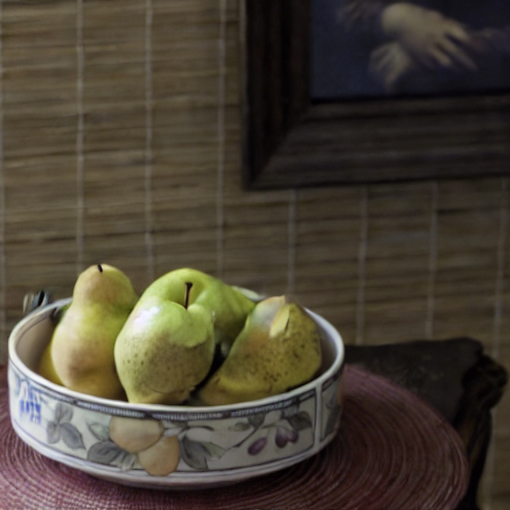DiffEdit
[[open-in-colab]]
Image editing typically requires providing a mask of the area to be edited. DiffEdit automatically generates the mask for you based on a text query, making it easier overall to create a mask without image editing software. The DiffEdit algorithm works in three steps:
- the diffusion model denoises an image conditioned on some query text and reference text which produces different noise estimates for different areas of the image; the difference is used to infer a mask to identify which area of the image needs to be changed to match the query text
- the input image is encoded into latent space with DDIM
- the latents are decoded with the diffusion model conditioned on the text query, using the mask as a guide such that pixels outside the mask remain the same as in the input image
This guide will show you how to use DiffEdit to edit images without manually creating a mask.
Before you begin, make sure you have the following libraries installed:
# uncomment to install the necessary libraries in Colab
#!pip install -q diffusers transformers accelerate
The [StableDiffusionDiffEditPipeline] requires an image mask and a set of partially inverted latents. The image mask is generated from the [~StableDiffusionDiffEditPipeline.generate_mask] function, and includes two parameters, source_prompt and target_prompt. These parameters determine what to edit in the image. For example, if you want to change a bowl of fruits to a bowl of pears, then:
source_prompt = "a bowl of fruits"
target_prompt = "a bowl of pears"
The partially inverted latents are generated from the [~StableDiffusionDiffEditPipeline.invert] function, and it is generally a good idea to include a prompt or caption describing the image to help guide the inverse latent sampling process. The caption can often be your source_prompt, but feel free to experiment with other text descriptions!
Let's load the pipeline, scheduler, inverse scheduler, and enable some optimizations to reduce memory usage:
import torch
from diffusers import DDIMScheduler, DDIMInverseScheduler, StableDiffusionDiffEditPipeline
pipeline = StableDiffusionDiffEditPipeline.from_pretrained(
"stabilityai/stable-diffusion-2-1",
torch_dtype=torch.float16,
safety_checker=None,
use_safetensors=True,
)
pipeline.scheduler = DDIMScheduler.from_config(pipeline.scheduler.config)
pipeline.inverse_scheduler = DDIMInverseScheduler.from_config(pipeline.scheduler.config)
pipeline.enable_model_cpu_offload()
pipeline.enable_vae_slicing()
Load the image to edit:
from diffusers.utils import load_image, make_image_grid
img_url = "https://github.com/Xiang-cd/DiffEdit-stable-diffusion/raw/main/assets/origin.png"
raw_image = load_image(img_url).resize((768, 768))
raw_image
Use the [~StableDiffusionDiffEditPipeline.generate_mask] function to generate the image mask. You'll need to pass it the source_prompt and target_prompt to specify what to edit in the image:
from PIL import Image
source_prompt = "a bowl of fruits"
target_prompt = "a basket of pears"
mask_image = pipeline.generate_mask(
image=raw_image,
source_prompt=source_prompt,
target_prompt=target_prompt,
)
Image.fromarray((mask_image.squeeze()*255).astype("uint8"), "L").resize((768, 768))
Next, create the inverted latents and pass it a caption describing the image:
inv_latents = pipeline.invert(prompt=source_prompt, image=raw_image).latents
Finally, pass the image mask and inverted latents to the pipeline. The target_prompt becomes the prompt now, and the source_prompt is used as the negative_prompt:
output_image = pipeline(
prompt=target_prompt,
mask_image=mask_image,
image_latents=inv_latents,
negative_prompt=source_prompt,
).images[0]
mask_image = Image.fromarray((mask_image.squeeze()*255).astype("uint8"), "L").resize((768, 768))
make_image_grid([raw_image, mask_image, output_image], rows=1, cols=3)


Generate source and target embeddings
The source and target embeddings can be automatically generated with the Flan-T5 model instead of creating them manually.
Load the Flan-T5 model and tokenizer from the 🤗 Transformers library:
import torch
from transformers import AutoTokenizer, T5ForConditionalGeneration
tokenizer = AutoTokenizer.from_pretrained("google/flan-t5-large")
model = T5ForConditionalGeneration.from_pretrained("google/flan-t5-large", device_map="auto", torch_dtype=torch.float16)
Provide some initial text to prompt the model to generate the source and target prompts.
source_concept = "bowl"
target_concept = "basket"
source_text = f"Provide a caption for images containing a {source_concept}. "
"The captions should be in English and should be no longer than 150 characters."
target_text = f"Provide a caption for images containing a {target_concept}. "
"The captions should be in English and should be no longer than 150 characters."
Next, create a utility function to generate the prompts:
@torch.no_grad()
def generate_prompts(input_prompt):
input_ids = tokenizer(input_prompt, return_tensors="pt").input_ids.to("cuda")
outputs = model.generate(
input_ids, temperature=0.8, num_return_sequences=16, do_sample=True, max_new_tokens=128, top_k=10
)
return tokenizer.batch_decode(outputs, skip_special_tokens=True)
source_prompts = generate_prompts(source_text)
target_prompts = generate_prompts(target_text)
print(source_prompts)
print(target_prompts)
Check out the generation strategy guide if you're interested in learning more about strategies for generating different quality text.
Load the text encoder model used by the [StableDiffusionDiffEditPipeline] to encode the text. You'll use the text encoder to compute the text embeddings:
import torch
from diffusers import StableDiffusionDiffEditPipeline
pipeline = StableDiffusionDiffEditPipeline.from_pretrained(
"stabilityai/stable-diffusion-2-1", torch_dtype=torch.float16, use_safetensors=True
)
pipeline.enable_model_cpu_offload()
pipeline.enable_vae_slicing()
@torch.no_grad()
def embed_prompts(sentences, tokenizer, text_encoder, device="cuda"):
embeddings = []
for sent in sentences:
text_inputs = tokenizer(
sent,
padding="max_length",
max_length=tokenizer.model_max_length,
truncation=True,
return_tensors="pt",
)
text_input_ids = text_inputs.input_ids
prompt_embeds = text_encoder(text_input_ids.to(device), attention_mask=None)[0]
embeddings.append(prompt_embeds)
return torch.concatenate(embeddings, dim=0).mean(dim=0).unsqueeze(0)
source_embeds = embed_prompts(source_prompts, pipeline.tokenizer, pipeline.text_encoder)
target_embeds = embed_prompts(target_prompts, pipeline.tokenizer, pipeline.text_encoder)
Finally, pass the embeddings to the [~StableDiffusionDiffEditPipeline.generate_mask] and [~StableDiffusionDiffEditPipeline.invert] functions, and pipeline to generate the image:
from diffusers import DDIMInverseScheduler, DDIMScheduler
from diffusers.utils import load_image, make_image_grid
from PIL import Image
pipeline.scheduler = DDIMScheduler.from_config(pipeline.scheduler.config)
pipeline.inverse_scheduler = DDIMInverseScheduler.from_config(pipeline.scheduler.config)
img_url = "https://github.com/Xiang-cd/DiffEdit-stable-diffusion/raw/main/assets/origin.png"
raw_image = load_image(img_url).resize((768, 768))
mask_image = pipeline.generate_mask(
image=raw_image,
- source_prompt=source_prompt,
- target_prompt=target_prompt,
+ source_prompt_embeds=source_embeds,
+ target_prompt_embeds=target_embeds,
)
inv_latents = pipeline.invert(
- prompt=source_prompt,
+ prompt_embeds=source_embeds,
image=raw_image,
).latents
output_image = pipeline(
mask_image=mask_image,
image_latents=inv_latents,
- prompt=target_prompt,
- negative_prompt=source_prompt,
+ prompt_embeds=target_embeds,
+ negative_prompt_embeds=source_embeds,
).images[0]
mask_image = Image.fromarray((mask_image.squeeze()*255).astype("uint8"), "L")
make_image_grid([raw_image, mask_image, output_image], rows=1, cols=3)
Generate a caption for inversion
While you can use the source_prompt as a caption to help generate the partially inverted latents, you can also use the BLIP model to automatically generate a caption.
Load the BLIP model and processor from the 🤗 Transformers library:
import torch
from transformers import BlipForConditionalGeneration, BlipProcessor
processor = BlipProcessor.from_pretrained("Salesforce/blip-image-captioning-base")
model = BlipForConditionalGeneration.from_pretrained("Salesforce/blip-image-captioning-base", torch_dtype=torch.float16, low_cpu_mem_usage=True)
Create a utility function to generate a caption from the input image:
@torch.no_grad()
def generate_caption(images, caption_generator, caption_processor):
text = "a photograph of"
inputs = caption_processor(images, text, return_tensors="pt").to(device="cuda", dtype=caption_generator.dtype)
caption_generator.to("cuda")
outputs = caption_generator.generate(**inputs, max_new_tokens=128)
# offload caption generator
caption_generator.to("cpu")
caption = caption_processor.batch_decode(outputs, skip_special_tokens=True)[0]
return caption
Load an input image and generate a caption for it using the generate_caption function:
from diffusers.utils import load_image
img_url = "https://github.com/Xiang-cd/DiffEdit-stable-diffusion/raw/main/assets/origin.png"
raw_image = load_image(img_url).resize((768, 768))
caption = generate_caption(raw_image, model, processor)

Now you can drop the caption into the [~StableDiffusionDiffEditPipeline.invert] function to generate the partially inverted latents!